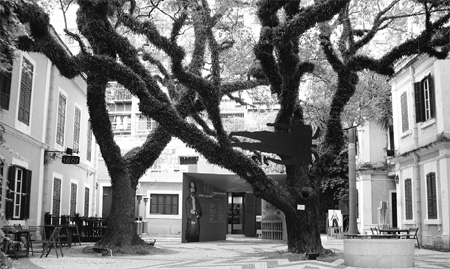House for old ladies
Updated: 2011-08-21 07:57
By Rebecca Lo(China Daily)
|
|||||||
|
The 19th-century Albergue is a U-shaped group of mustard-yellow buildings centered around a leafy courtyard. Provided to China Daily |
Once a home for elderly women, the Albergue is slowly gaining recognition as a shelter for a brand new generation - of artists. Rebecca Lo visits this unusual enclave of creativity.
In the summer of 2008, I was first introduced to the Albergue by Macao-based Portuguese architect and urban planner Nuno Soares. He took me on a spin around the city to all of his favorite hidden architectural gems. Although I have been visiting Macao ever since I was a child, I had never been to the Sao Lazaro (St. Lazarus) district, sandwiched between Mount Fortress and St. Michael Cemetery.
Affectionately known as the Old Ladies House, the Albergue used to be a shelter for the elderly run by the Holy House of Mercy (Santa Casa da Misericordia).
It is a U-shaped group of mustard-yellow buildings centered around a leafy courtyard. The 19th-century structures off Calcada da Igreja de Sao Lazaro on No 8 was completely restored in 2005 and is now home to a number of creative industries, galleries and studios.
Being in the area is like stepping into a time capsule, as the quiet colonial houses crisscrossed by black and white cobblestone lanes seem to belong to a bygone era despite being just minutes from the bright lights of the Grand Lisboa, Wynn and MGM Macao.
As we strolled around, Soares explained that the buildings are hybrids.
"Its architecture is a mixture of Chinese and Portuguese," he says. "It is not a copy of Portuguese architecture. Local materials are used in the roof tiles."
He pointed to a pilaster fashioned after bamboo as an example and adds that, "the shutters are typical of ones found all over Southeast Asia." Underneath the staircase, a perforated floral frieze provides a decorative yet practical touch, as it allows natural breezes to flow through the wooden treads.
St. Lazarus is one of Macao's oldest neighborhoods.
It developed organically around the chapel of Our Lady of Hope, built in 1557 and one of the city's three oldest churches. Dom Belchior Carneiro Leitao founded a leper hospital at the site of the Albergue and named it St. Lazarus, after the patron saint of lepers.
Soon, the church became known by the same name. After the diocese of Macao was established in 1576, St. Lazarus church became its cathedral for many decades before the high church was relocated to St. Paul's in 1623. The current incarnation of St. Lazarus church was completed in 1886, and caters to the area's predominantly Chinese Catholics. In 1882, the leper hospital was relocated and the site operated as a home for elderly spinsters and widows until 2000.
Today, part of the southern wing of the building houses the studio of architect Carlos Marreiros. A dedicated professional who specializes in historical preservation, he lectures frequently and is active in organizations including the Macao Architects Association, of which he is president. In 2002, he was recognized by Macao's Chief Executive Edmund Ho Hau-wah with the Medal of Professional Merit.
He was also instrumental in transforming the Albergue into a creative hub, handpicking and inviting Lines Lab designers Manuel Correia da Silva and Clara Brito to set up an onsite studio.
Trained in industrial design, Da Silva first came to Macao when he was a young boy. He set up the multi-disciplinary design brand Lines Lab with partner and fashion designer Clara Brito. While Lines Lab is the fashion and retail side of his business, Da Silva has continued to work on industrial projects such as public furniture installations.
On a recent weekday visit to the Albergue district, there was a lot of diversions. A retrospective exhibition showcased the work of the late Portuguese architect Francisco Figueira. Another show, titled Wind Horse Walking, featured the collective videos, photos and paintings of local artists Alice Kok, Carolina Rodrigues and Joey Ho.
An outdoor exhibition displayed traditional Portuguese tiles, while inside, there were art workshops organized by Casa de Portugal in Macao and Albergue 1601, a restaurant that featured the art of local talents. But despite the events, the Albergue still lacks traffic. "The area is developing slowly," Da Silva acknowledges.
The Cultural Affairs Bureau is doing its part in helping to inject life into the neighborhood.
Not only is its office located in nearby Tap Seac Square, but it has also restored a heritage building into a music school. Many historic details, such as cornices and shutters, were incorporated into the school's designs - even old wells were kept in situ as decorative elements. The building's small rooms proved ideal for individual lessons.
And with more children in the area than ever before, the Albergue's creative future seems promising.
You can contact the writer at sundayed@chinadaily.com.cn.
(China Daily 08/21/2011 page15)
